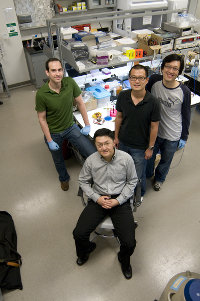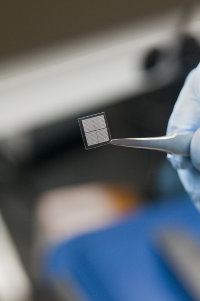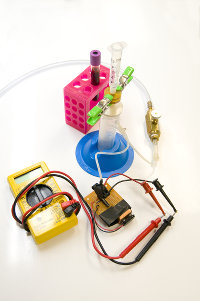Featured Faculty: Siyang Zheng

Dr. Siyang Zheng's (front center) research group including Ramdane Harouka, Tim Yeh and Mingda Zhou (back left to right).
Work by an interdisciplinary team led by Siyang Zheng, assistant professor of bioengineering, may give cancer patients a better chance of survival after their tumors have metastasized.
"Even if you get rid of the primary tumor, you may have other tumors," he said. "The patient might have clusters of tumor cells that break off that can reach other places in the body in a process called 'metastasis.'"
These floating pieces, called circulating tumor cells (CTCs), may eventually anchor themselves in other parts of the body, forming new tumors.
For cancer patients, the most dreaded piece of news is that the disease has spread.
"Ninety percent of patients die because of metastasic tumors, not the primary tumor," Zheng stated.
But Zheng's team – which includes researchers from the University's Material Research Institute, Hershey Cancer Institute and Huck Institutes of the Life Sciences – is developing a device that may help monitor CTCs.
Called a flexible micro spring array (FMSA), the tiny 's'-shaped structure works like the mesh on a screen door, allowing red blood cells to easily pass through while capturing the CTCs.
"If we have an efficient way to separate out the CTCs from blood cells, we can do a better job of monitoring," he said.
Information from the FMSA would allow doctors to not only engage in preventative treatment for a patient, but also make adjustments as CTC data is returned.
The diminutive filter measures a square centimeter and is ten micrometers thick. The bioengineer says the FMSA offers three major advantages: flexible device structure, low driving pressure operation, and high porosity.
Having device flexibility and low driving pressure operation are keys to preserving cell viability, Zheng stated. The FMSA's ability to bend and stretch means blood cells striking the array won't take a hard hit – think a padded floor or wall. And lower pressure will keep the cells from breaking apart.
The FMSA's high porosity lets researchers process a larger blood volume and paint a more accurate picture of the number of CTCs in the bloodstream. It takes just a few minutes to filter a test tube amount of blood with Zheng's FMSA.
CTCs are very much a needle in the haystack. Zheng said, "In a whole tube of blood, it can be in the single digits. In the samples we try, it's normally less than a couple hundred out of a billion blood cells."
The effort remains in the early stages. The team still needs to create multiple mechanisms to detect and analyze the CTCs captures on the device's surface, among other things.
However, the work has been promising enough to Garner Zheng a 2012 National Institutes of Health (NIH) Director's New Innovator Award last September. The award, which is part of the NIH's High Risk High Reward research program, is designed to encourage creative thinkers to pursue exciting and innovative ideas about biomedical behavioral research.
Eighty-one winners from the program were awarded a total of approximately $155 million.
He also received a four-year, $720,000 Research Scholar Grant from the American Cancer Society.
As the effort grows, Zheng said he's looking to expand his research team and is seeking a technician to assist with the research.
Ultimately, Zheng said, "If we can perfect this method, the doctor can draw a sample and see how the therapy is working and, if necessary, change the therapy."
-- Curtis Chan
- Photos courtesy of the College of Engineering.
Dr. Zheng can be reached at siyang@psu.edu or at 814-865-8090.



